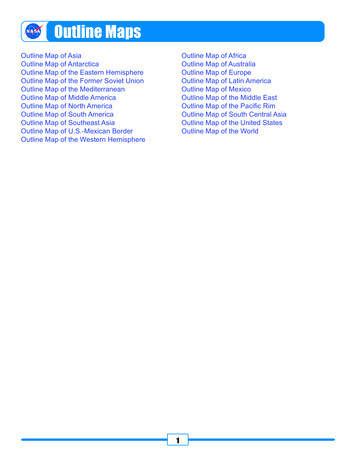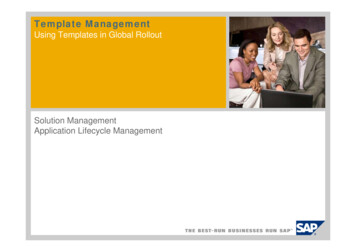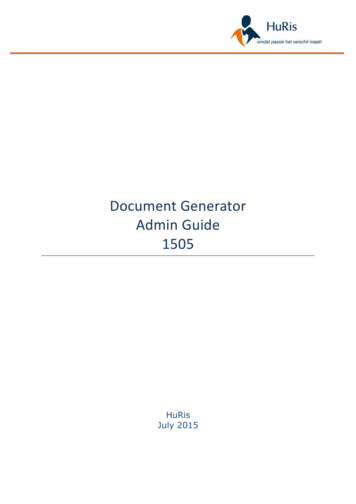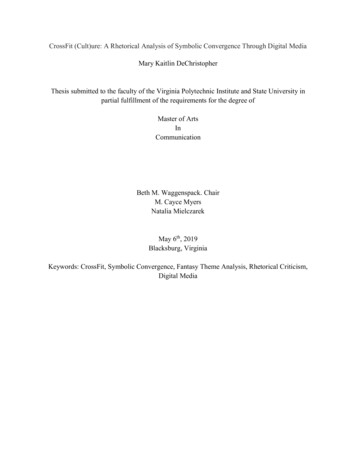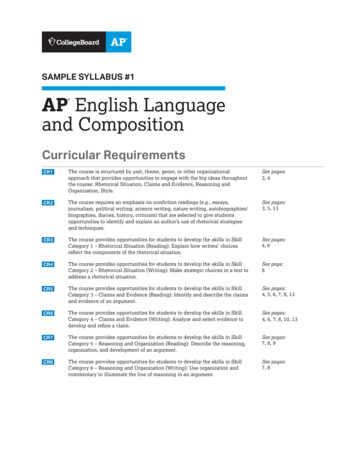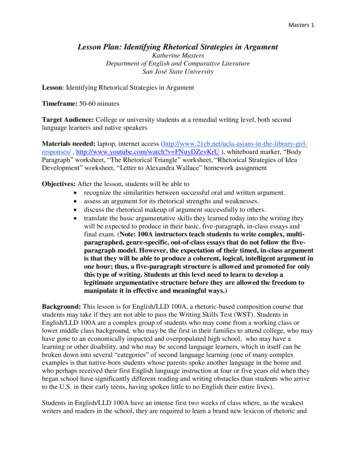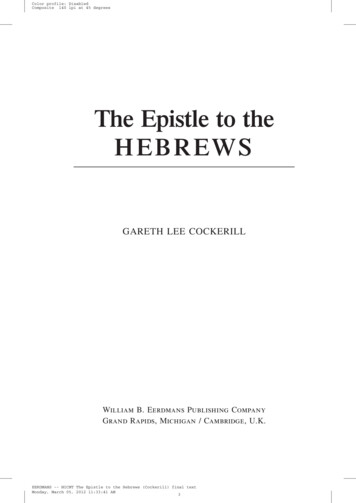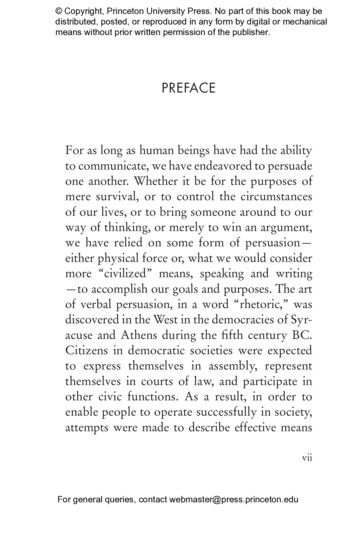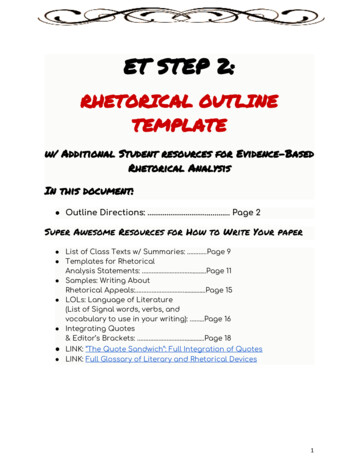
Transcription
ET STEP 2:RHETORICAL OUTLINETEMPLATEw/ Additional Student resources for Evidence-BasedRhetorical AnalysisIn this document: Outline Directions: . Page 2Super Awesome Resources for How to Write Your paper List of Class Texts w/ Summaries: Page 9 Templates for RhetoricalAnalysis Statements: .Page 11 Samples: Writing AboutRhetorical Appeals: .Page 15 LOLs: Language of Literature(List of Signal words, verbs, andvocabulary to use in your writing): .Page 16 Integrating Quotes& Editor’s Brackets: .Page 18 LINK: “The Quote Sandwich”: Full Integration of Quotes LINK: Full Glossary of Literary and Rhetorical Devices1
OUTLINE with EVIDENCE:RHETORICAL ANALYSIS ESSAYINTRODUCTION TO OutlineGOAL OF THIS TASK: Plan and write an outline of your rhetorical analysis essaythat includes evidence from required primary and secondary sources. Your outline willhelp you write a paper which not only discusses the rhetoric of your primary sourcesbut allows YOU to practice those same rhetorical techniques in order to develop yourown writer’s voice.Don’t try to cover everything. Instead, focus on examples from your text—specificexamples from beginning, middle, and end—that represent your author/speaker’s styleas a whole.Read ALL directions, including these, IN ORDER. Otherwise, you WILL be confused.DRAFT THE OUTLINEPART I: DRAFT AND ORGANIZE YOUR CLAIMS.Write three claims that compare and/or contrast specific rhetorical techniques thatyour authors/speakers use most effectively to persuade the audience.Be sure to note which rhetorical strategies you are basing your comparisons on . Focuseach statement on ONE central similarity or contrast . Example:While both Trump and Obama relied on eventual amplification to build enthusiasm in their respective audiences,Trump tends to employ more hyperbole to get the audience worked up , while Obama preferred extendedmetaphors to gradually win the audience over through the course of his speech.CLAIMS :1. :2. :3. :2
ORGANIZE YOUR CLAIMSIn the blanks provided above, NUMBER your claims in order of LEAST important first toMOST important last . When you get to PART III (OUTLINE), rewrite these claims as TopicSentences for your outline.PART II: DRAFT A WORKING THESIS.Direction: Draft a working Thesis for your paper. You may use one of the thesistemplates provided but are NOT required to do so.IMPORTANT NOTE: Y our thesis should establish that your paper will focus on a) closereading your primary source texts for rhetorical devices and appeals while also b)evaluating their effectiveness from a 21 st century perspective.THESIS TEMPLATE 1, FOCUSING ON CONTRAST: While both authors profoundly effected theiraudiences by , it is ’s speech/writing that continues to have a greaterappeal for 21 st Century audiences because .THESIS TEMPLATE 2, FOCUSING ON COMPARISON: Both authors inspired their audiences of thetime through brilliant use of [technique] ; nonetheless, [name] rings moretrue with 21 st Century audiences because [explain] .WRITE THE THESISA. Review and highlight the key terms in your three claims. Specifically, whichrhetorical techniques did you focus on in each?B. In your thesis, be sure to use key terms from your most important claim.C. Write a single, assertive sentence that summarizes these three claims:THESIS STATEMENT (Use in your outline)PART THREE: OUTLINE with EVIDENCE.DIRECTIONS: You are using this outline format to PLAN your essay. However, this is aMINIMUM number of paragraphs. You MAY develop more paragraphs as you actuallywrite your essay and discover more points to make!This outline will contain evidence from your sources. Remember that evidence should bea balance between direct quotes of word-for-word information (10 words or less) andparaphrase of essential information that would be too long to quote directly.3
Both direct quotes and paraphrase must be given credit using MLA parentheticalcitations .I.Introductiona. Hook .b. Introduce authors and works .c. ThesisII.Body paragraph 1a. Topic Sentence:i. Evidence from primary source 1 that supports the claim in your topicsentence? ()ii. What evidence from a secondary source could contribute to youranalysis of these techniques?a) (b) ())What rhetorical appeal(s) do these strategies support the most?Logos, Ethos, and/or Pathos? iii. Evidence from primary source 2 that supports the claim in your topicsentence? ()iv. What evidence from a secondary source could contribute to youranalysis of these techniques?a) . (b) . ())What rhetorical appeal(s) do these strategies most createfor the audience? Logos, Ethos, or Pathos? 4
v. How would you compare the effectiveness of each author’s rhetoric from a21 st Century perspective? vi. Why? b. Close & Connect to Thesis III.Body Paragraph 2a. Topic Sentence:i. Evidence from primary source 1 that supports the claim in your topicsentence? . ()ii. What evidence from a secondary source could contribute to youranalysis of these techniques?a) ()b) ()What rhetorical appeal(s) do these strategies support the most?Logos, Ethos, and/or Pathos? iii. Evidence from primary source 2 that supports the claim in your topicsentence? ()iv. What evidence from a secondary source could contribute to youranalysis of these techniques?a) . (b) . ())What rhetorical appeal(s) do these strategies most createfor the audience? Logos, Ethos, orPathos? v. How would you compare the effectiveness of each author’s rhetoric from a21 st Century perspective? 5
vi. Why? b. Close & Connect to Thesis IV.Body Paragraph 3a. Topic Sentence:i. Evidence from primary source 1 that supports the claim in your topicsentence? . ()ii. What evidence from a secondary source could contribute to youranalysis of these techniques?a) ()b) ()What rhetorical appeal(s) do these strategies support the most?Logos, Ethos, and/or Pathos? iii. Evidence from primary source 2 that supports the claim in your topicsentence? ()iv. What evidence from a secondary source could contribute to youranalysis of these techniques?a) . (b) . ())What rhetorical appeal(s) do these strategies most createfor the audience? Logos, Ethos, orPathos? v. How would you compare the effectiveness of each author’s rhetoricfrom 21 st Century perspective? vi. Why? b. Close & Connect to Thesis 6
V.Evaluation of Effectivenessa. Topic Sentence:b. Comments on Primary Source 1 c. Comments on Primary Source 2 d. Final evaluation of both sources: VI.Counterclaimsa. Topic Sentence with counterclaim . b. Evidence for counterclaim: . ()c. Why are such views incorrect or false? . VII.d. Evidence: . ()e. Sum up your response to counterclaims. . ()Conclusiona. Bookend w/Hook . b. Explain significance of your findings . c. Last words. Don’t use clichés! . 7
PART IV: CONSIDER RHETORICAL DEVICES YOU COULD USE.Referring to your outline and your texts, make a list with examples ofsome effective rhetorical devices you may wish to use in your own paper.For your examples, you may want to take some of your ideas from theoutline and develop them into persuasive claims, illustrations, anecdotes,and analogies you plan to use in your paper.You have the 8 rhetorical devices from the “I Have a Dream” speech byMLK. However, you can CLICK HERE for a full glossary of literary andrhetorical devices.Rhetorical Device youfoundHow it could look in your own writing8
CLASS TEXTS & SUMMARIESNOTE: While the Gideon Burton texts are required for use as secondary sources, you MAY useany of the other texts on this list (except for the class notes) as your optional “5 th source” andbeyond. “MLA Signal Phrases”o Use this to help you write effective, logical sentences that clearly express yourideas.o ings-speech/ Linking Words & Signal transition-words.html “What Is Rhetoric?” by Gideon Burton.o Establishes importance of rhetoric for persuading audiences. “Persuasive Appeals” by Gideon Burtono Establishes the balance of appeals necessary for effective rhetoric incommunication (rhetorical triangle) “I Have a Dream: 8 Heart-Stopping Rhetorical Techniques of King’s Speech” (note:“Devices” and “Techniques” are the same thing).o Illustrates how speakers and writers use alliteration, allusion, amplification,antithesis, conduplicatio, litotes, metaphor, parallelism, and overall passionate,persuasive language.o Web ings-speech/ “How to Write a Rhetorical Analysis Essay”o Provides an general outline of how to organize your paper “How Donald Trump Answers a Question”o Gives example of how you could break down language by noting repetition ofwords and how a speaker uses connotation to send a message—even whenthat message deliberately avoids certain information Baxter’s “Inflection and the Breath of Life”o Explains and illustrates the importance of inflection—the tonal emphasis onwords—and how emphasis and syntax breathes life into language and allowsthe reader to believe and “re-enact” or live in the moment when reading orlistening9
Class noteso Gives details about the purpose of literature (fiction and nonfiction) andexplains how authors use connotation and subtext to give the written andspoken word a deeper meaning that goes beyond the surface of any “text” Morgan Parker’s Poetryo Demonstrates how connotation and subtext can be achieved using poeticdevices of rhetoric such as rhyme, meter, alliteration, connotation, wordplacement, etc.10
RHETORICAL ANALYSIS TEMPLATESRemember, you will need to change the words of any template to fit the material you arewriting about. Templates are NOT “fill in the blank” answers! Also, blanks do not represent lengthof words or limitations on how much you can write.Blanks may be one word or entire clauses.Use of parentheses indicates the need for a parenthetical citation of direct quotes orparaphrases from sources.INTRODUCTION STATEMENT TEMPLATESIntroduction of Primary Source Title of Work and Author (used in Introductory paragraph):, in [his/her] article “ ,” claims “ .”Introduction of Secondary Source Title of the work and author with direct quote (used in bodyparagraphs):, in [his/her] article “ ,” claims “ ” ()Author’s credentials and/or background:, an advocate for , claims “ ” (, a former [state profession or title], asserts “ ” ().)SUMMARY STATEMENT TEMPLATESConcerning , both and achieve aeffect on their respective audiences through use of ,and .Though audiences may find a difference in , both andmanage to establish through a powerful use of.RHETORICAL ANALYSIS STATEMENT TEMPLATESANALYSIS OF RHETORICAL DEVICES11
One of his/her main points extends from , which helps the audience understand.The author/speaker’s skillful use of informs listeners of ; theword/phrase “ ” ( ) implies , which .With the word/phrase “ ” ( ), successfully employs; this technique persuades the audience to due to.The speaker/author’s insistence on the word/phrase “ ” isemphasized/reflected/engaged multiple times: “ ” in the of thespeech, “ ” in the part, and “ ” in thepart ( ).EVALUATION OF RHETORICAL APPEALS (POSITIVE)successfully reminds the audience of his/her experience with , thefact of which appeals to the of audience because ( ).Because (his/her .), the author wins us over with and firmly establishesThe purpose of the (.) is to convince that , sinceEVALUATION OF RHETORICAL APPEALS (NEGATIVE )fails to win his/her audience on the point of for onereason/several reasons: .Unfortunately, the lack of in ’s use of throughout thespeech/text results in for the reader and for the speaker.While certainly succeeds in , one problem exists: .Due to the word/phrase “ ” (because .), the author loses a bit of credibility simplyThe purpose of “ ” is to convince that , since.While is out to convince his audience , it seems obvious that.CONTRASTING AUTHORS’ RHETORIC12
While uses to persuade the audience to ,prefers to employ in his/her speech for the purpose of.Although seems fond of , on the other hand buildshis/her argument on .Both authors maneuver the audience with ; however, stresses, while prefers .COMPARING AUTHORS’ RHETORICBoth authors build their arguments with to persuade the audience to, and both prefer to employ in to maneuver the audience into.Although both seem fond of , a careful listener will notice that bothand also share another stylistic similarity:( ).Both authors build their maneuver the audience with ; furthermore,stresses , while also evokes( ).13
Samples: WRITING ABOUTRHETORICAL APPEALS (ETHOS,PATHOS, LOGOS)Use the terms correctly. Ethos, Pathos, and Logos are general appeals, effects caused in theaudience by an author’s use of rhetorical devices to invoke specific thoughts and emotions.These words describe the balance between an audience’s trust in the author (ethos), beingmoved emotionally (pathos), and being persuaded (or not) by facts and logical arguments(logic). Use the words Ethos, Logos and Pathos sparingly, and use them to describe how anauthor’s choice of words and examples affects the audience.Here are some good and bad examples:BAD: T he Logos appeal in Smith’s article is very logical because of T he Canterbury Tales.GOOD: S mith’s article establishes balance based on Logos w hen he cites The Canterbury Tales.BAD: T here is large amount of sensing E thos i n Smith’s poetry because the audience trusts him.GOOD: S mith’s poetry builds trust, and this appeal to E thos a llows the audience to trust him.VERY BAD: W hile the audience’s use of Pathos really works for his writing, Smith still loses theargument.GOOD: W hile Smith really attempts to elicit P athos through his use of tragic anecdotes, he still loses theargument.NOTE: If you are uncomfortable using the Greek words, you may also simply substitute words like“logical,” “credible/credibility,” and “emotional” when describing how an author’s choices affect theaudience.14
SHORT LIST OF LOLS (LANGUAGE OFLITERARY ANALYSIS)ANALYSIS (s)Instigates(s)Intone(s)Make(s) use e(s)Vocalize(s)ANALYSIS ceCharacterizationClauseClose onDistinctionEmphasisEpiphanyEpiphany15
EvocationExtended icRhythmShiftShort StorySimileSpeakerSpeechStressSubtexSuspension of zationVoiceWordPLOT TERMSForeshadowingSuspenseConflictExpositionRising ActionCrisisResolution/DenouementPoint of rick(s)Trigger(s)Utilize(s)Work(s)FICTION & POETRYTurnSyntaxToneShiftMeterRhymeEnjambment (line break)Caesura (pause due to comma orsemicolon)MotifConceitExtended ter:ProtagonistAntagonistMajor CharacterMinor CharacterStatic Character,Dynamic Character16
Stock CharacterStereotypeArchetypeFIGURATIVE LANGUAGESynecdocheDead MetaphorEuphemismOxymoronMetonymyAllusionTone (formal & informal)CultureThesaurusInferenceNuancePunDouble entendreTONE WORDSLINK:https://www.google.com/search?q tone wheel&sxsrf ource lnms&tbm isch&sa X&ved 0ahUKEwj d3s-L kAhVBhq0KHQFNBOsQ AUIEigB&biw 1227&bih 574#imgrc CLPrGLDrKvN4sM:Integrating QUotes & Editor’sBracketsINTEGRATING QUOTES: Remember, quotes must flow grammatically to be integrated. If youcould take the quote mark away and your sentence still read correctly, then thequote has been fully integrated!EDITOR’S BRACKETS: Sometimes you must provide editor’s brackets to help your quote flowsmoothly or to include words that help the reader understand the meaning. Example:Joe Smith often likes to claim “[that] of all the Charlie Browns in the world, [you’re] the CharlieBrowniest.”17
THESIS STATEMENT (Use in your outline) _ _ _ PART THREE: OUTLINE with EVIDENCE. DIRECTIONS: Y ou are using this outline format to PLAN your essay. However, this is a MINIMUM number of paragraphs. You MAY develop more paragraphs as you actually write your essay and discover more points to make! This outline will contain evidence from .
